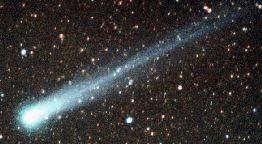Lecture 22 - Comets, Asteroids and Meteorites (12/3/98)
 Moons and Rings --- | ---
The Sun
Moons and Rings --- | ---
The Sun


Reading:
Chapter 7-3, 7-4 (ZG4)
Comet Hyakutake as viewed from Kitt Peak in March 1996.
Photo by Tod Lauer.
 |
Key Question: |
What are comets and asteroids made of?
|
|---|
 |
Key Principle: |
Differentiation
|
|---|
 |
Key Problem: |
How do you determine the albedo
and size of a small asteroid?
|
|---|
 |
Key Quote: |
|
|---|
Investigations:
- Comets
- Are or are not comets "icy asteroids"?
- When and where were comets formed?
- Why do comets develop "tails" as they approach the Sun?
- What are the main parts of a comet?
- What is the difference between the dust tail and ion
tail of a comet?
- What did the Giotto probe find during its rendezvous with Halley?
- What are the typical orbits of a periodic comet?
- What was the first comet to have its orbit determined? When?
- Where is the Oort Comet Cloud and what is its significance?
- Where is the Kuiper Comet Belt?
- What is the estimated total mass of all the comets in the solar system?
- What are the possible fates of comets that happen into the inner
solar system?
- What is the relationship between comets and meteor showers?
- What impact have comets had on life on Earth?
- Asteroids
- What is in the gap between Mars and Jupiter at 2.8 AU (predicted
by Bode's rule)?
- Who discovered the first asteroid Ceres in 1801?
- How many asteroids have known orbits now?
- How many asteroids are there with size more than 200 km? 1 km?
- What process explains the fact that there are many more small asteroids
than large ones?
- How large (in AU) is the main asteroid belt?
- What are the Kirkwood gaps in the asteroid belt due to?
- Where are the Trojan asteroids associated with Jupiter?
- Why are Earth-crossing asteroids important?
- What are the main types of asteroids, as classed by composition?
- How do we know what asteroids are composed of, even though we
have never sampled one?
- What is the composition gradient in the main belt, and what is
its significance?
- How often do asteroids collide with each other?
- Which satellites are believed to be captured asteroids? Why?
- What formed the asteroid belt in the first place?
- Meteors & Meteorites
- How large are most meteors that we see on a typical night?
- How large must a meteoroid be to survive passage through the
Earth's atmosphere?
- What types of meteorites are there, as classified by composition?
- What do meteorites tell us about the primitive solar nebula?
- What is the relationship between meteorites and asteroids?
- Why are there no icy meteorites of cometary origin (or are there)?
- What is the significance of carbonaceous chondrites?
- Which type of meteor is believed to be part of the asteroid Vesta?
- What are chondrules?
Minor Bodies in the Solar System:

Asteroid 243 Ida and its companion Dactyl
(NASA/GSFC).
See
The Nine Planets for asteroid, comet and meteorite
images and links:
Near Earth Asteroid Rendezvous (NEAR):
Mars is not the only solar system object under study by NASA spacecraft.
The NEAR spacecraft is on its way to an orbit around the asteroid 433 Eros,
which it should reach insertion on Jan 10, 1999.
The first faint image of Eros was obtained on November 25, 1998!

Asteroid 253 Mathilde, courtesty Johns Hopkins.
The
Near Earth Asteroid Rendezvous (NEAR) mission passed within 1200 km of
the main-belt asteroid
253 Mathilde on June 27, 1997. The
first
close-up images of a C-type (carbonaceous) asteroid were obtained.
Along with Pathfinder, the NEAR mission is another phenomenal success for the
NASA Discovery program of cheaper and better spacecraft sent out to
explore our solar system.
Comets on the Web:

The nucleus of Halley from the Giotto spacecraft.
(NASA/ESA).
The 1985-86 encounter of Comet Halley by the
Giotto spacecraft
gave us a close-up look at a cometary nucleus.
We found jets of vapor shooting out of the mineralized thin crust. These
jets can steer a comet slightly, varying its orbit. This gas ends up in
the coma of the comet, and eventually is lost in its tail.
There are a number of good comet-related resources on the World-Wide Web:
 Prev Lecture ---
Prev Lecture ---
 Next Lecture ---
Next Lecture ---
 Astr11 Index ---
Astr11 Index ---
 Astr11 Home
Astr11 Home
smyers@nrao.edu
Steven T. Myers
 Moons and Rings --- | ---
The Sun
Moons and Rings --- | ---
The Sun

 Moons and Rings --- | ---
The Sun
Moons and Rings --- | ---
The Sun









 Prev Lecture ---
Prev Lecture ---
 Next Lecture ---
Next Lecture ---
 Astr11 Index ---
Astr11 Index ---
 Astr11 Home
Astr11 Home